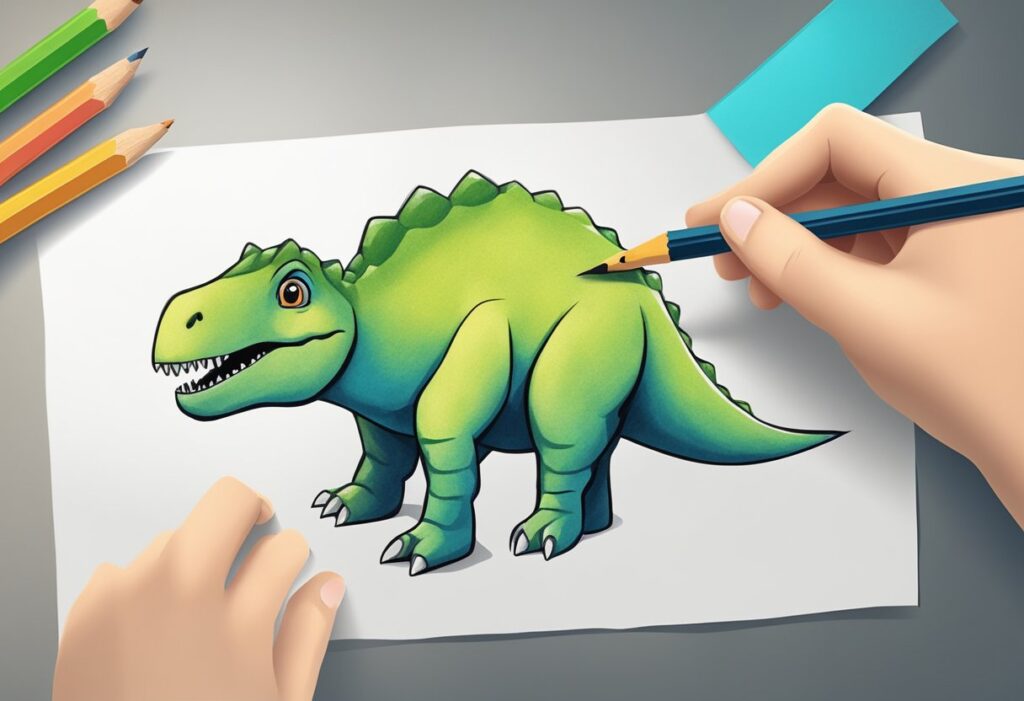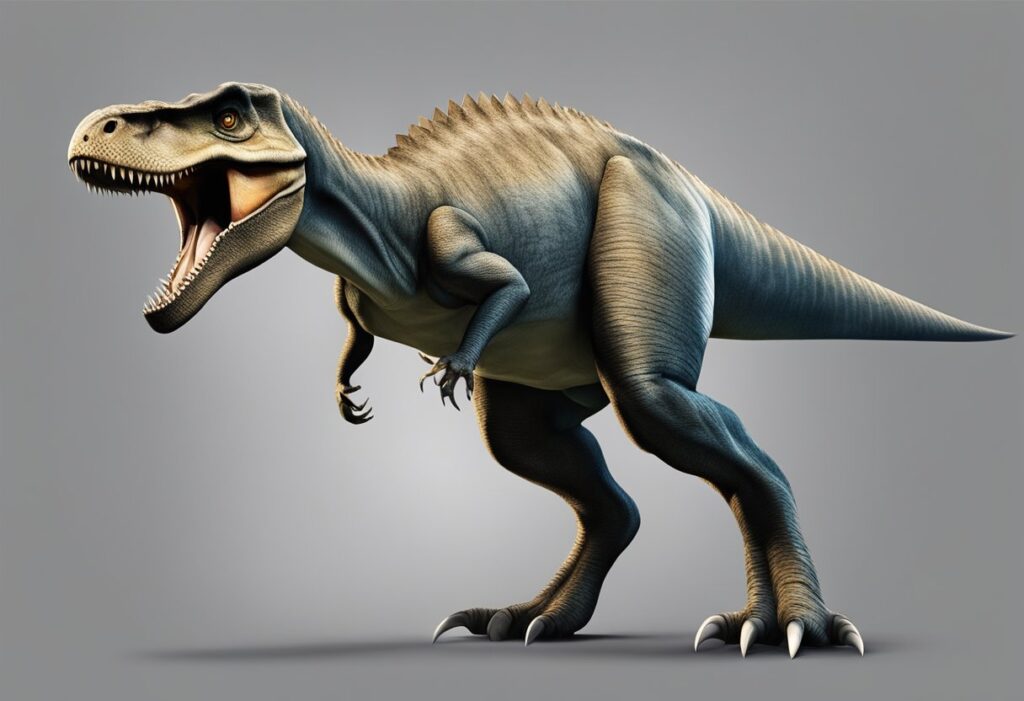Drawing a dinosaur can be a fun and challenging activity for both kids and adults. Whether you want to create a realistic T-Rex or a cute cartoon Stegosaurus, following a step-by-step guide can help you achieve your desired result. In this article, you will learn how to draw a dinosaur step by step, using simple shapes and lines to build up your drawing.

Before you start, it’s important to choose the type of dinosaur you want to draw and gather reference images to help you visualize its features. Once you have a clear idea of what you want to draw, you can begin by sketching out the basic shapes and proportions of your dinosaur. This will serve as the foundation for your drawing and allow you to add details and texture later on.
As you progress through the steps, be patient and take your time. Don’t worry if your dinosaur doesn’t look perfect at first – practice makes perfect! By the end of this article, you will have a completed dinosaur drawing that you can be proud of. So grab your pencils and let’s get started!
Materials Needed

To draw a dinosaur, you’ll need a few essential materials. Here’s a list of what you’ll need:
Drawing Supplies
- Pencils (2H, HB, 2B, 4B)
- Eraser
- Sharpener
- Ruler
- Paper (preferably sketch paper)
Optional Supplies
- Colored pencils
- Markers
- Paints
When choosing your drawing supplies, it’s important to select high-quality materials that will allow you to create detailed and accurate drawings. You don’t need to spend a lot of money on expensive supplies, but you should avoid low-quality materials that may smudge or break easily.
Pencils are the most important tool for drawing a dinosaur. You’ll need a range of pencils with different lead hardness to create different shades and textures. An eraser is also essential for removing mistakes and refining your drawing.
A sharpener and ruler will help you create precise lines and angles, while sketch paper provides a smooth surface for drawing. If you want to add color to your drawing, colored pencils, markers, or paints can be used to add depth and dimension to your dinosaur.
The key to drawing a great dinosaur is to have the right materials and to practice regularly. With the right tools and techniques, you can create a realistic and impressive dinosaur drawing that will impress your friends and family.
Basic Dinosaur Anatomy

Drawing a dinosaur can be a daunting task, but understanding the basic anatomy of a dinosaur can make it much easier. Here are some key features to keep in mind when drawing a dinosaur:
Head
The head of a dinosaur is one of its most distinctive features. Most dinosaurs had a long, pointed snout, with sharp teeth for tearing flesh. The eyes were usually large, and set on either side of the head for better peripheral vision. The head was often supported by a long neck, which allowed the dinosaur to reach high up into trees.
Body
The body of a dinosaur was generally large and bulky, with a long tail for balance. The legs were thick and powerful, with three or four toes on each foot. Some dinosaurs, like the stegosaurus, had bony plates or spikes on their back for protection.
Skin
The skin of a dinosaur was covered in scales, which varied in size and shape depending on the species. Some dinosaurs, like the tyrannosaurus rex, had rough, pebbly skin, while others, like the triceratops, had smoother skin with smaller scales.
Posture
Finally, it’s important to consider the posture of your dinosaur. Most dinosaurs walked on all fours, with their legs positioned directly beneath their bodies. Some, like the velociraptor, were more bird-like, and walked on two legs. Pay attention to the position of the head, tail, and legs to create a realistic and dynamic pose.
By keeping these basic features in mind, you’ll be well on your way to drawing a convincing and accurate dinosaur.
Sketching the Basic Shape

When drawing a dinosaur, it’s important to start with the basic shape. This will help you to get the proportions right and create a solid foundation for your drawing. In this section, we’ll go over the steps for sketching the basic shape of a dinosaur.
Drawing the Body Outline
To start, draw a large oval shape for the body. This will be the main part of your dinosaur. Next, draw a smaller oval shape for the head and a long, thin oval for the tail. These shapes will help you to get the basic proportions of your dinosaur right.
Adding the Head and Tail
Once you have the basic body shape down, it’s time to add the head and tail. Draw a smaller oval shape at one end of the body for the head. Then, draw a long, thin oval shape at the other end for the tail. Make sure that the tail is in proportion with the rest of the body.
Sketching Legs and Arms
Now that you have the basic body shape, head, and tail, it’s time to add the legs and arms. Draw two short, thick legs at the bottom of the body. Then, draw two short, thin arms near the top of the body. Make sure that the legs and arms are in proportion with the rest of the body.
By following these steps, you should now have a basic outline of your dinosaur. In the next section, we’ll go over how to add more details to your drawing.
Detailing the Dinosaur

Once you have sketched out the basic outline of your dinosaur, it’s time to add some detail to bring it to life. This section will cover how to define the features and create texture and patterns to make your dinosaur look more realistic.
Defining the Features
To make your dinosaur look more realistic, you need to define its features. This means adding details like the eyes, nostrils, teeth, and claws. Use reference images to guide you and make sure you are accurately representing the species of dinosaur you are drawing.
One way to add detail is to use shading to create depth and dimension. Use a darker shade to create shadows where necessary, and a lighter shade to highlight areas that catch the light. This will make your dinosaur look more three-dimensional and realistic.
Creating Texture and Patterns
Dinosaurs had a variety of textures and patterns on their skin, from scales to feathers to bumps and ridges. Adding these details will make your dinosaur look more authentic.
To create scales, draw small, overlapping ovals or circles in a pattern that follows the contours of the dinosaur’s body. For feathers, draw long, thin lines that taper at the ends and overlap to create a feathery texture. Bumps and ridges can be created by drawing curved lines that follow the shape of the dinosaur’s body.
Don’t be afraid to experiment with different textures and patterns to create a unique look for your dinosaur. With practice, you’ll be able to create realistic and detailed drawings that capture the essence of these prehistoric creatures.
Finalizing the Drawing

Congratulations! You have successfully sketched out a dinosaur. Now, it’s time to finalize the drawing by cleaning up the sketch and adding shadows and highlights.
Cleaning Up the Sketch
First, take a look at your sketch and identify any unnecessary lines or smudges. Erase them carefully using a kneaded eraser or a regular eraser. Make sure to keep the essential lines intact.
Next, use a fine-tipped pen or marker to trace over the essential lines of the drawing. This will make the lines more defined and distinct. Be careful not to smudge the ink while drawing.
Adding Shadows and Highlights
Now that you have a clean sketch, it’s time to add some depth to the drawing by adding shadows and highlights.
Start by identifying the light source in the drawing. This will help you determine where the shadows and highlights should fall. Use a pencil to lightly shade in the areas that would be in shadow. Then, use an eraser to create highlights in the areas where the light source would hit.
To create a more realistic effect, use a blending stump or your finger to blend the shading and highlights together. This will create a smooth transition between the light and shadow areas.
With these final touches, your dinosaur drawing is complete! You can now proudly display your artwork or use it as a reference for future drawings.
FAQs

What are the basic steps to start drawing a dinosaur for a beginner?
If you’re new to drawing dinosaurs, it’s important to start with the basics. Begin by sketching out the basic shape of the dinosaur, including its head, body, and limbs. Then, add details such as the eyes, teeth, and scales. Remember to use light, loose strokes at first, and gradually build up the details as you go.
Can you provide simplified instructions for drawing an easy T-Rex?
To draw a simple T-Rex, start by sketching out the basic shape of its body, including its head, neck, and tail. Then, add details such as the eyes, nostrils, and teeth. Don’t forget to give it short, stubby arms! Finally, add texture and shading to give your T-Rex some depth and dimension.
What techniques should be used to draw a realistic dinosaur?
To draw a realistic dinosaur, it’s important to pay attention to details such as the shape of its bones, the texture of its skin, and the way its muscles move. Use reference images to guide your drawing, and focus on creating a sense of depth and dimension through shading and texture.
How can kids learn to draw dinosaurs in a fun and easy way?
Drawing dinosaurs can be a fun and engaging activity for kids of all ages. To make it more approachable, start with simple shapes and encourage kids to experiment with different colors and patterns. You can also use dinosaur coloring books or online tutorials to guide their drawing process.
What are some tips for creating a cute and simple dinosaur drawing?
To create a cute and simple dinosaur drawing, focus on using soft, rounded shapes and bright colors. Use large eyes and a smiling mouth to give your dinosaur a friendly, approachable look. Don’t be afraid to add fun details such as spots or stripes to give your drawing some personality.
